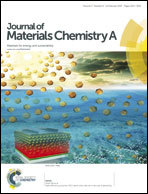Effects of various π-conjugated spacers in thiadiazole[3,4-c]pyridine-cored panchromatic organic dyes for dye-sensitized solar cells†
Abstract
A series of new metal-free panchromatic organic photosensitizers based on a strong electron-deficient thiadiazole[3,4-c]pyridine core has been prepared and applied in dye-sensitized solar cells. The incorporation of the auxiliary thiadiazole[3,4-c]pyridine unit can effectively adjust the HOMO and LUMO energy levels, to design small band-gap photosensitizers with panchromatic absorption. The impacts of various π-conjugated spacers on the absorption properties, electrochemical properties and photovoltaic performances have been investigated systematically. The sensitizer Y3 with a benzene unit adjacent to the anchoring cyanoacrylic group produces a higher photocurrent and photovoltage in cell performance, as compared to Y1 and Y2 with thiophene and n-hexylthiophene unit adjacent to the anchoring group, respectively. Further structural optimization in Y4 with a n-hexylthiophene π-conjugated spacer inserted between the donor and thiadiazole[3,4-c]pyridine core results in the best photovoltaic performance. For comparison, the sensitizer Y5 with thiophene instead of n-hexylthiophene in the molecule exhibits the most inferior performance; this demonstrates that the long alkyl chains can effectively improve the cell performance by suppressing the dye aggregation on TiO2 film, enhancing electron injection efficiency, and retarding charge recombination by shielding the surface of TiO2 from I3− ions. The overall conversion efficiency of liquid–electrolyte DSSC based on Y4 shows the highest efficiency of 6.30% with a short-circuit photocurrent density (Jsc) of 12.54 mA cm−2, an open-circuit photovoltage (Voc) of 0.749 V, and a fill factor (FF) of 0.671, under standard global AM 1.5 solar light condition. Density functional theory calculations and electrochemical impedance spectroscopy analysis of these sensitizers provide further insight into the molecular geometry and the impact of the different π-conjugated spacers on the photophysical and photovoltaic performance.
![Graphical abstract: Effects of various π-conjugated spacers in thiadiazole[3,4-c]pyridine-cored panchromatic organic dyes for dye-sensitized solar cells](/en/Image/Get?imageInfo.ImageType=GA&imageInfo.ImageIdentifier.ManuscriptID=C4TA05350H&imageInfo.ImageIdentifier.Year=2015)

 Please wait while we load your content...
Please wait while we load your content...